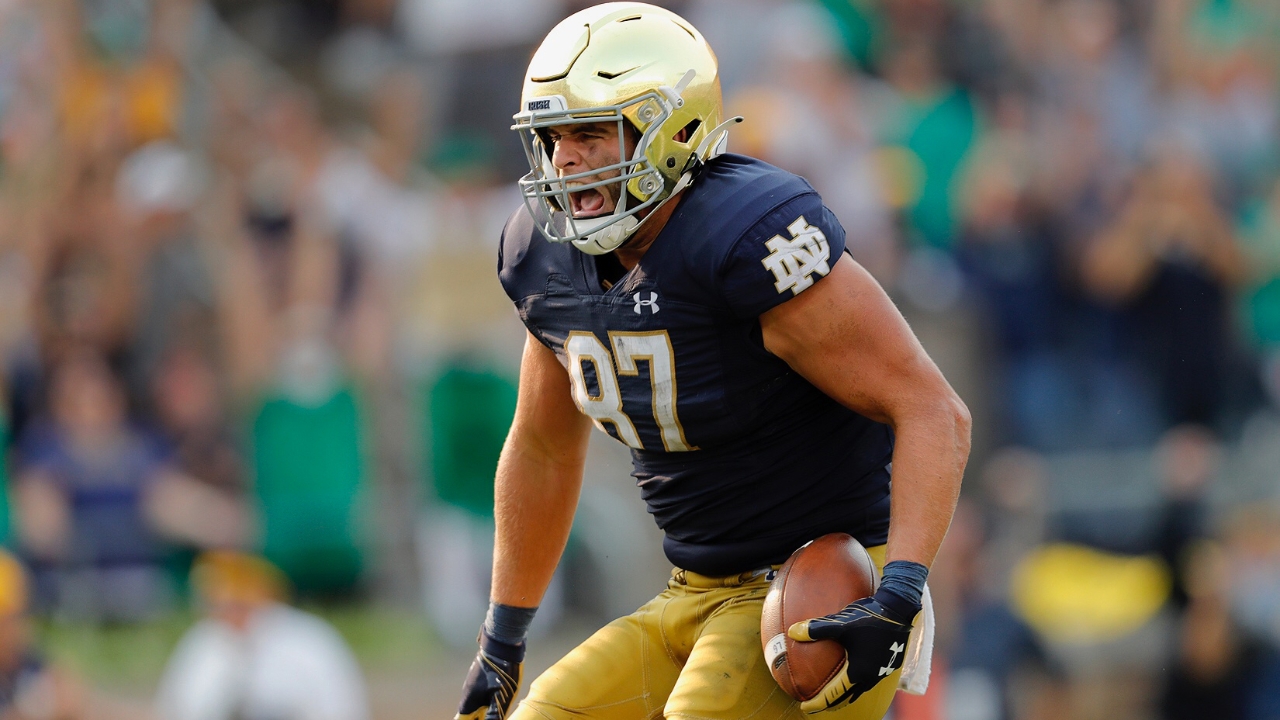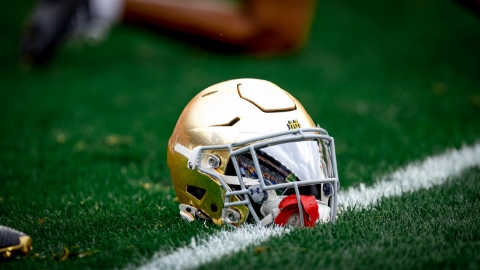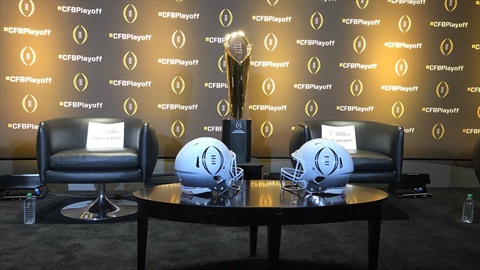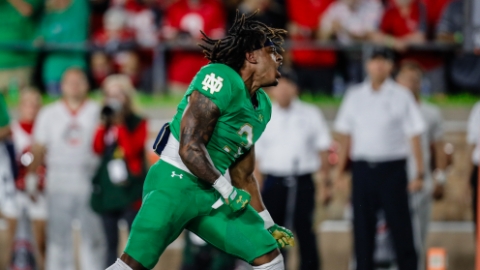
For Notre Dame’s offense in 2021, there’s two ways to look at the season: everything before Virginia Tech and everything from that game on.
After that is when everything flipped. Everyone is aware of how things went down with changes in personnel and philosophy. They also know that the offense ended up playing defenses that weren’t nearly as good as the ones they faced in the first half of the season.
What really matters with all of that is the results. Tommy Rees’ group went from averaging to 5.1 yards per play in those first five games to 6.9 in the final seven. That’s a significant improvement, but it comes with the “yeah, but” of playing mostly bad defenses.
Oklahoma State’s defense might be the best Notre Dame has faced. I don’t see any result where the Irish are getting close to their final seven game average in YPP when Okie State has given up over 6.0 YPP only once.
But getting close to that YPP number or putting up 30 or more points isn’t how Notre Dame’s offense should be evaluated after this game. All that will matter is that the offense makes enough plays to win. Against this good of a defense, that’s going to mean big plays.
They are going to be critical. Oklahoma State is the best in the country at getting to the passer (1st in sack rate) and they are second in 3rd down defense. They are fourth in Stuff rate (tackles for zero yards or less). Long drives aren’t a sustainable way to score touchdowns against this group.
67% of touchdowns they allowed this season were on drives that went seven plays or less. That means that if Notre Dame isn’t working with short fields, like Baylor had in the Big 12 Championship game, they’ll need big plays to help them get into the end zone.
That’s nothing new for how Notre Dame has produced points in the back half of the season. Out of their 32 touchdown drives on offense, 71.9% (23) featured at least one play of 20-yards or more.
Luckily the Irish have Michael Mayer, who has averaged 22.1 yards per reception while catching 16 of 19 intermediate targets (between 10 and 19 yards). They also have Kevin Austin, who has more contested catches on deep targets than any Power 5 receiver in the country. Lorenzo Styles Jr. averages 10.5 yards after the catch, which is an elite number and one that only makes it more clear he needs more touches.
Obviously there are more than those three capable of making a big play and it will truly have to be a by committee approach against this defense, but they are going to struggle to score enough points to win the game if they only produce three plays of 20-yards or more like they did against the two other top-10 F+ defenses they faced earlier, Wisconsin and Cincinnati.
I suppose Oklahoma State quarterback Spencer Sanders could go Full Mertz like he did against Baylor, and you don’t ever want to go Full Mertz, but that isn’t a reliable way to win a game. Notre Dame is going to have to be explosive on offense and if they are, they’ll likely win the Fiesta Bowl.
2. As Rees pointed out during his media availability this week, it's a fair expectation that Oklahoma State will attempt to take away Mayer as much as possible. As Rees explained, multiple defenders are likely going to be assigned to Mayer.
“Yeah, they've shown it throughout the year. They've played other good individuals. The kid from Iowa State, they had some things on third down to double him. That's clearly part of what they do. I think the biggest focus for them will probably be third down; how do we get a couple people around him on third down?
“The kid at Iowa State, they literally put two guys on him and said, "Hey, we're going to take him away." If you watch the NFL, you saw that against the Packers a couple weeks ago (with Davante Adams). Clearly, third down, critical downs, maybe red zone, that will be part of what they want to do. There's a lot of unknowns right now with their defense, obviously with the change in coordinator and extra time to prepare and what they want to do.
“We got to be multiple in how we use Michael [Mayer] and make sure that we don't become stagnant with where we want to play him and find ways to create opportunities. Look, if they want to double him, that usually means we got a favorable match-up somewhere else. So we got to make sure that we're seeing that and adjusting to it.”
It’s a solid bet that Oklahoma State will plan to defend him from the slot. He’s aligned there on 50% of his snaps when Notre Dame passes. Combining that with when he’s in-line, 86.9% of the time he is inside.
He’s only been lined up out wide on 13.1% of pass snaps if they want to get him isolated, especially in the red zone, I think we may see more of that for Mayer in this matchup.
3. It’s surprising to me that some didn’t realize that Jordan Botelho was listed as a Rover on the depth chart for the Fiesta Bowl. He’s been playing Rover since the Georgia Tech game and done a pretty good job of it considering he’s asked to play in space quite a bit.
The move is temporary to get him on the field now. When a position is crowded, no one wants to see talent not allowed more opportunities because of it. Botelho is a Vyper, but Rover works for now.
The question then becomes what will happen if Isaiah Foskey and Justin Ademilola both come back next season. If that’s the case, then Vyper will be stacked again. It’s a little bit like what happened with Jamir Jones with Julian Okwara and Daelin Hayes ahead of him. Jones was good enough to play more and Mike Elston moved him around to get him some reps at the strong side end as well.
Botelho is going to need to play a lot more in 2022 and he’s going to need to be given a lot more opportunities to rush the passer. He’s been on the field for 52 pass plays, but has been in coverage for 24 of those snaps.
On 28 pass rush snaps, he’s totalled five pressures. He needs more chances to get after the quarterback next season.
4. We will find out more clarity on his status when Marcus Freeman next speaks on Friday, but I’d be careful to rule Cam Hart out because his leg was wrapped at practice when he was dressed in uniform. This isn’t exactly out of the ordinary to have that with a player and if he is dressed, that typically means that he is someone they are hoping/working towards playing.
Having someone not take reps like that at practice or even someone limping around in the middle of the week is normal. We just don’t hear about it because regular season practices aren’t open to the media and teams don’t have to disclose injuries like they do in the NFL where if a player doesn’t practice or is limited, we find out about it every week.
If he isn’t available to play, TaRiq Bracy playing the field corner is obvious. What happens in terms of depth after that is a bit more unknown.
I know Ryan Barnes was listed on the two-deep, but I would think there is a far better chance that Ramon Henderson is the third corner with him sliding over from safety if Hart isn’t playing.
5. With it looking more and more like Harry Hiestand will come back and be the next offensive line coach at Notre Dame, I thought it would be worth looking back on some numbers to see how his line performed overall compared to what we saw with Jeff Quinn.
I think rushing yards per game are pretty useless and even yards per carry can’t tell the whole story when it comes to evaluating the line. Raw sack numbers don’t do it either. There’s also context that has to be included like with this season and injuries at left tackle for Notre Dame.
The three statistics that I look at can be found on Football Outsiders. The first is Opportunity rate, which is described like this by them.
The percentage of carries (when four yards are available) that gain at least four yards, i.e. the percentage of carries in which the line does its job, so to speak.
The second is sack rate, which is pretty self-explanatory. The third is Power Success rate, which measures how often a team converts running the football on 3rd or 4th and short.
They only have tracked these since 2014 so 2012 and 2013 aren’t included for Hiestand, but the running game finished 24th, 4th, 46th, and 11th in Opportunity rate from ‘14 to 2017. They finished 30th, 56th, 95th, and 65th in sack rate. Another spot tracked sack rate in 2012 and 2013 and Notre Dame finished 35th and 2nd in those two seasons. They were 44th, 58th, 16th, and 38th in Power Success Rate.
For Quinn from 2018-2021, they finished 112th, 81st, 30th, and 79th in Opportunity rate. They were 23rd, 106th, 32nd, and 73rd in Power Success rate. They were 82nd, 16th, 38th, and 106th in sack rate.
So, for the most part, it’s advantage Hiestand.
It’s not a universal thing to be near the top in all of those categories to have a great line. For example, the Michigan line that just won the Joe Moore Award was only 68th in Opportunity rate, but they were 34th in Power Success Rate and 2nd in sack rate. The Alabama line that won the award in 2020 29th, 5th, and 7th in those categories. The LSU line that won it in 2019 was 12th and 18th in Opportunity rate and Power Success rate, but only 64th in sack rate.
It’s pretty clear that Hiestand’s lines were better than Quinn’s. We know individual development is going to be advanced under him because he has the track record to prove it. We’ll see if his lines can be better than his best groups he coached during his previous time in South Bend.
6. Things are really looking good for the Irish to land safety Peyton Bowen this weekend. If they do, that would make six blue-chip commits on defense in the 2023 class on top of the eight they just signed in December with the 2022 class. It has all the makings of the foundation of a championship defense and they are only going to add more of that talent in ‘23.
They have some work to do to catch up on offense, but they do have 11 blue-chips in the two combined classes. But let’s face it, how the rest of the ‘23 class on offense shakes out and how it is perceived after they sign will depend a lot on the quarterback they ultimately land.
The bad news is that it’s uncertain who that quarterback would be at the moment. The good news is that quarterback is much deeper in ‘23 than it was the previous cycle and all of their top targets have exciting potential.
Jackson Arnold is a fantastic athlete with a big arm and special ability. Dante Moore delivers the ball with the rush in his face about as well as anyone I’ve watched in recent cycles and he’s built to deliver the ball in tight windows and become a master of the RPO game.
Christopher Vizzina isn’t a true dual-threat, but he is no statue in the pocket. His balance as a passer and his deep ball really jump out. Avery Johnson has to physically develop more, but his ceiling is sky high. He’s also a dynamic runner in a way that even these other dual-threats are not.
Nicholaus Iamaleava might be more of a long shot, but his raw talent is right up there with the best quarterbacks in the last five years. His highlights are littered with “wow” throws.
Rees has to close on one of them, but every one of these players could end up ranked as a top-100 prospect in this class. There’s a high probability that they’ll end up with a great prospect and that’s great news not just for the quarterback position, but hopefully for the way they need to recruit the wide receiver position as well.



